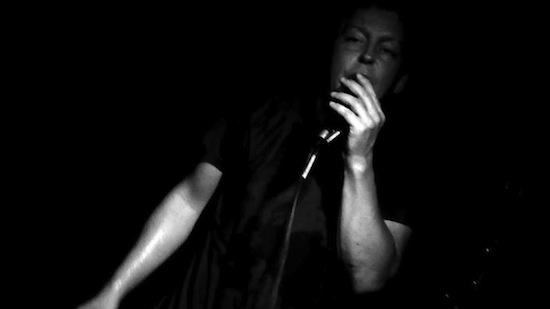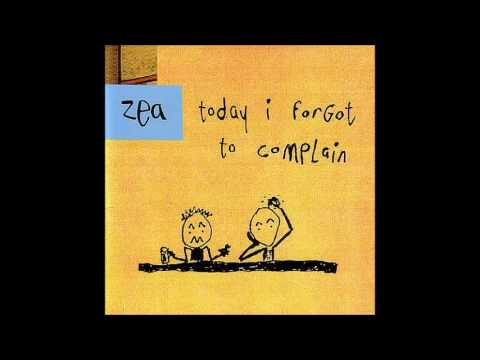Most people know Arnold de Boer as the current front man of the "essential" Dutch punk band The Ex; a role he has held since 2009, when he was asked to take over vocal duties after GW Sok left. The jovial Frisian is also the leader – and now sole member – of Zea.
This sharp, ever-curious and inspiring alternative pop act celebrates 20 years of hand-to-mouth, "gleeman" existence this autumn (with "2000 shows in 35 countries on 6 continents" to their name, too). Starting to make waves at the fag end of the 1990s, Zea were one of the first bands to foreshadow the current glut of great Dutch underground guitar "pop" which began to appear round 2005-6.
Think here of de Nieuwe Vrolijkheid and Appie Kim, The Hospital Bombers and Vox Von Braun, and currently Rats on Rafts and The Homesick. We asked Arnold (over a set of mails during a US tour with The Ex) to pick ten "mementos" from his life or back catalogue to share with tQ.
1. The Dictaphone
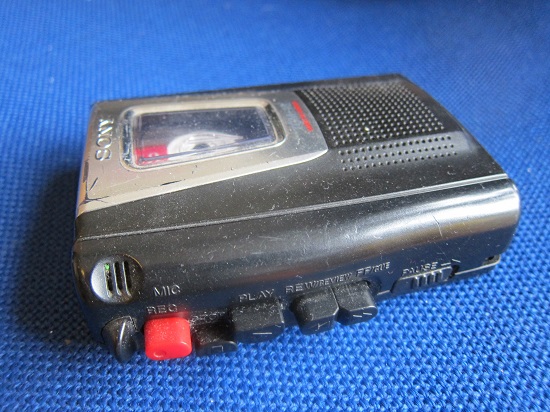
Your Dictaphone! I can’t imagine you without this. I think your Dictaphone is the lodestone for your music, both as Zea and in The Ex; as it constantly feels like you are getting your ideas and lyrics from this. It maybe also acts as something that keeps people at arm’s length, even though you are a very sociable chap. Is that fair comment?
Arnold de Boer: I don’t use the Dictaphone like a journalist, and I’m not like a philosopher who’d probably step back to keep their perspective, to be the fly on the wall. For me it works as a quick memory device and like a sketchbook. It’s not only for words and lyrics, as I also record guitar lines and other musical ideas on it; and sometimes I record a first version of a song on it. This first recording can turn out to be the best and goes straight onto the album. But it also acts in another way. When I speak my observations or blare my rants into it, it stops me from stepping off my bike or throwing a stone through the window of, for example, some corporate bank. I wonder if I hadn’t climbed on a stage years ago, would I now be continuously ranting in people’s faces?
2. The Music Box
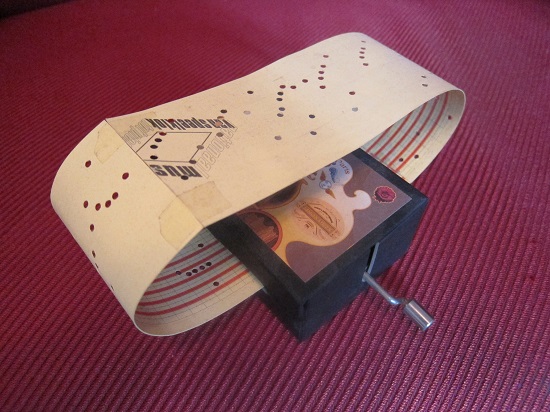
And a Music Box (known in Dutch as the speeldoos). What’s the fascination here? It can’t be THAT boring up there in Friesland, can it? All those wide open space and glowering skies, all those dikes, all those cows?
AdB: When I lived in Friesland I had to cycle twenty kilometers to go and see a band. The road, which was also the road to school, became a bit boring I must admit. Cows don’t get boring, their curiosity saved me. But this little machine means something different to me. I bought it at the Speelklok Museum, for street organs and the like, in Utrecht. It’s a fantastic museum.
If there is one traditional Dutch musical instrument, then it’s the street organ and it is great. It’s loud, it’s full on, it’s annoying sometimes, and it was also the first mechanical instrument. The songs played on it are pricked in a “book”, and the holes in the cardboard trigger the valves. You have to pump air through the thing. The distance between the holes decides the rhythm and the person who rolls the book through the machine decides the speed. This speeldoos is a very small version of the same instrument. I pierced my own melody in and stuck the two cards together to create a loop. Listen to my song ‘Waitress (for Adrienne Shelly)’ on The Beginner, and you will hear it.
The speeldoos is the most rudimentary form of MIDI and I love it. For years I worked with an Atari (no internal memory, only working on floppy discs). I ran Cubase on it and triggered the sampler, drum computers and synths I have at home. I am not very technical and not a gadget freak, but I am a control freak and I love to make, record and mix all parts of the song myself. Then you have all these machines that can be used for making all these new sounds. I see the speeldoos also as a link to Dick Raaijmakers and Edgard Varèse both of whose music is like the “delta blues of electronic music” for me.
3. Bert Schierbeek – De Deur (1972)
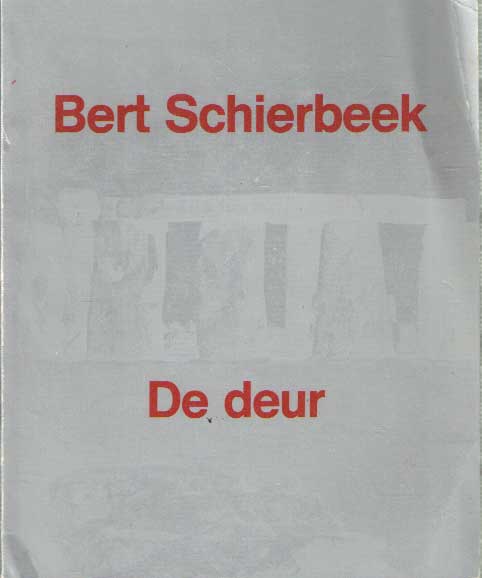
I’m interested that you’ve picked a book from Bert Schierbeek. A man with principles. A resistance fighter in World War II, a “provincial”, someone from the east of the Netherlands, and someone who really used his life to drive his work. I bet you can see what "journalistic parallels" I could draw with you. Does any of his history click with you, Arnold?
AdB: He’s from the countryside and his poetry is direct and very powerful. I first heard of him through a short documentary that Johan van der Keuken [see a later question, Ed] made about him, which is very beautiful. I saw his character and personality coming through in his poetry, which is very personal indeed. World War II and living on the countryside must have made him the man that I saw in the film, and it reminded me of people I know from my childhood, from the village where I’m from.
I’ve not read this, but I asked about and some of my Dutch friends say that this is a strange and sad book.
AdB: I read this book shortly after my mother died. Most of the poems in De Deur are about his wife who passed away. They are breathtaking in their direct, repetitive style. The few, carefully chosen words he uses to build up the sentences, and the way he puts them in a line and lets the words take each other’s place, is like music to me. I took inspiration from this for my own music and writing, and I find comfort in the poems when I miss my mum.
I also like the fact there’s a pic of Stonehenge on the cover too. Does this mean you’re mystical Arnold?
AdB: I used the title poem, ‘De Deur’, to convince Kat, the drummer of The Ex, that Enormous Door was a good title for an album by The Ex & Brass Unbound. But I noticed the Stonehenge image long after I bought the book. I once heard a Norwegian band singing the lines about Stonehenge: "Is it a giant birthday cake or a prison far to easy to escape? Why did they build Stonehenge?" [‘Stonehenge’ by Ylvis is something that rivals Spinal Tap for silliness.] Now I find it hard to think of anything else when I see it. I can see it as an archetypal burial mound, where the individual poems are the stones raised over a grave. That makes sense to me. But I am not really mystical. I like metaphysics, but more in a cartoony kind of way.
4. Johan van der Keuken
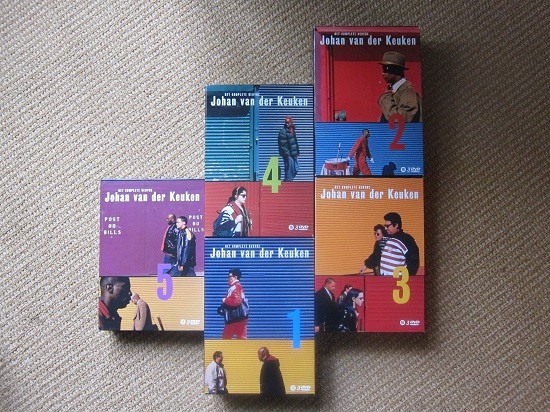
I can sort of see why Johan van der Keuken the Dutch documentary maker and traveller inspired you. Tell us about what you find so interesting about his work, what makes him stand out for you.
AdB: The first documentary I saw of his was Bewogen Koper (Brass Unbound). [You can watch a short clip here.] And it’s the best music documentary I know. He goes to Rajasthan, Indonesia, Ghana and Suriname, and captures the local brass bands in a brilliant way. The music is amazing. The story line he follows is open and down to earth and makes you believe that you see the truth. But it’s Van der Keuken’s story, which is also very clear. I like that sort of paradox. An other of his masterpieces is Amsterdam Global Village which I find so good that I had to take samples from it and use them in my song ‘De Zwemmende Stad’. This four hour “epos” is about Amsterdam, my city, and about a dozen of its people who come from all over the world to live there. Van der Keuken follows these people back to where they originally came from. All short stories in themselves, like songs on an album. I sometimes try to make music like he makes film.
5. Photo of handpainted Zea concert banner in Ghana
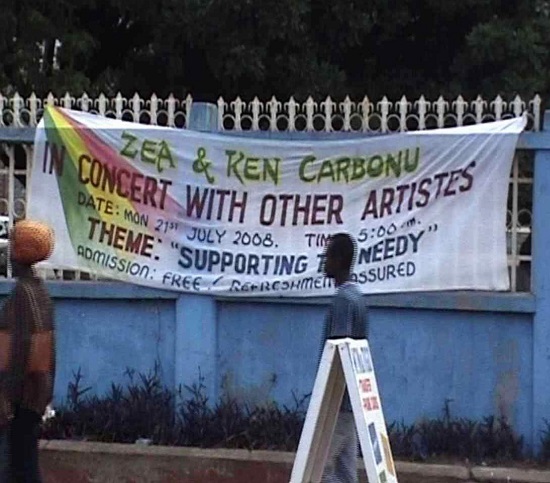
You have a long-standing love of African music and in particular Ghanaian music it seems. What is it about Ghana?
AdB: My sister lived and worked in Ghana for two years. She shared a house with a Ghanaian musician called Ken Carbonu and his family, who she was introduced to by a former Dutch priest. Ken and me exchanged compilation CD-Rs, and wrote letters. Ken then invited me to visit Ghana, to come and play and record, and to see the country. In 2008, after I left Remko (a former Zea bandmate) behind in Russia, I took some time out, and went with my wife Rixt to Ghana for a month. I knew this calypso song from the fifties by Lord Kitchener called ‘Birth Of Ghana’ about the country gaining independence from Britain, and decided to learn it. I played it on the evening of our arrival at Ken’s, and surprised the whole family; especially the parents, who knew the song from the old days. We had a great time. Ken’s younger brother took one of my songs called ‘An Experience Of Trouble’, learned it and played a truly fantastic version. And when Rixt and I came back from a two weeks trip around the country, Ken had set up a show in an old Catholic church. One of the best concerts I ever did, it was unforgettable.
What’s it like to play, as a Frisian kid in Ghana? What do they make of you?
AdB: The people say, “You make great rock music!”, which adds a nice counter-perspective to all that navel-gazing “genre talk” back home. They love my ‘Song For Electricity’ because the power goes down every other day. They like the wild songs and my dancing moves. Most people have never seen a European play live, jump around, scream, push buttons, throwing a guitar around in front of their noses. They like it. They want musicians to put the fire in their bodies and wreck the place, and they see me do it.
You brought King Ayisoba to The Netherlands, and got him to record in Voorhout of all places.
AdB: He’d never seen a studio like that before. He loved the sound and was impressed by how Corno Zwetsloot recorded him (and me) live, all in one go. And how Corno could still could control the sound really well on that antiquated mixing desk of his, and make it sound great. Actually, Ken Carbonu and Joop Visser, the former priest, invited me to come back to Ghana in 2012 and help them set up a studio there. They had a small budget and studio equipment is way more expensive in Ghana then over here. Even better, I got things on the second hand market in Holland, which I did; so I came to Ghana with suitcases full of equipment and set up a studio next to the house of Father Joop who lives on the same compound as Ken and his family. I introduced a few things I learned from Corno in his Next to Jaap Studio in Voorhout. After a week of building and installing it became sort of logical that the name of the studio in Oyarifa, Ghana would be called "Next To Joop Studio".
6. Photo of Zea’s car, “Sue” in Amsterdam
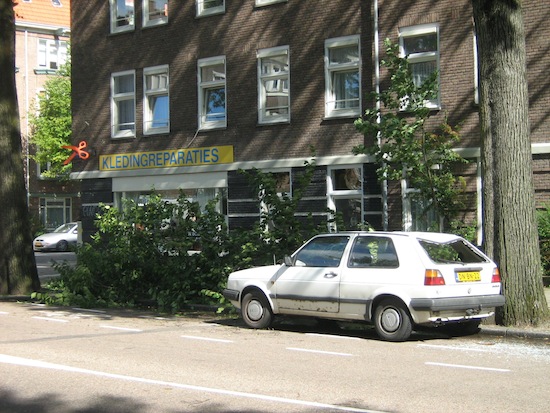
A Car Named Sue! As Uncle Monty said in Withnail and I: "There is no true beauty without decay." Tell us about some journeys in it.
AdB: Well you see it here on it’s last working day, just after it has been hit by a tree, which lies behind it. The front and rear windows were smashed, the roof was destroyed and it all happened in a heavy storm in October 2010 when two trees in Amsterdam decided to give in. One was the chestnut tree in the garden of the Anne Frank house, the one she wrote about, and the other one landed on my car. I had done 550,000 kilometers and was ready to reach a million I believe, but not anymore. We have been all over Europe in that car, as far as Macedonia. When you spend so many hours in a car on the road, from gig to gig, that car becomes a band member. Even when we had trouble and had to have it fixed, we never missed a gig. Touring is quite a special activity, if you do it right you get into a “zoooom” state [sic] where everything is about music. Which is very nice. When I asked my girlfriend if she thought the car was a boy or a girl and what name we should give it, she said: “It’s a boy, for sure, but you should called him Sue."
I do like where you parked “Sue”, next to clothing repairs. Says it all, sustainability, endurance, make do and mend. Zea qualities?
AdB: Yes, I grew up in a family shop, started by my great-great grandfather who sold cloth from a horse and cart to the farmers in the south west of Friesland. When my parents took over the shop from my grandparents it was a store for carpets, curtains, blankets, and clothes for all ages and sexes. Lots of other things too; prams, you name it. I learned what it is like to be your own boss; the working hours are elastic and nobody tells you what to do. Don’t expect any presents but all help is welcome. I have had a few jobs when I was young but it was clear to me that I wanted to be my own boss. So when I started Zea I automatically did everything myself; no managers, no contracts, no lawyers, that is the motto. So I write, play, record, mix and master everything myself. I make my own artwork, videos, website and run my own label. I drive the car and manage the tour. I couldn’t do it differently.
Please tell me that Terrie Hessels hasn’t driven it.
AdB: Ha, no, Terrie is a great driver, actually. I’m writing this reply sitting behind him in the van driving from Jersey City to Portsmouth, on day five of The Ex’s current USA tour! It’s nice and things have been great so far. The east coast looks beautiful with all the multicoloured trees. An Indian summer, they call it.
7. ‘Clocks’ by Coldplay)
Is this clock image something to do with the carnage (and rightfully so) you’ve enacted upon Clocks, by Clodplay [sic, sic]?
AdB: For every song I make I make a drawing, and this one is for the Zea version of Coldplay’s Clocks. we were invited to come and play our song, ‘Flying Objects Will Reach You Soon’ live, and also pick two other songs from the top 100 selection for the VPRO’s JaaBoo Kerstshow in 2003, a Christmas radio show that played the alternative top 100 picked by its listeners. I loved ‘Ya Ya Ya’ by The Detroit Cobras, so I picked that one to play. Now, during the year (during which I had been working a lot in my parents shop) I had heard Coldplay’s ‘Clocks’ about a million times on the radio. I thought the melody was not bad, but would sound better played at twice the speed and with that soapy, whiny sound “turned around”. I also expected the song to end high in the top 100 which meant we would play prime time in the show. I picked ‘Clocks’ and cut it up, and treated it with Gabber and Bhangra beats. In 2004 Job de Wit played it during a VPRO radio special about Coldplay, who had just played a concert in The Netherlands. He got lots of phone calls from people who had just seen the concert, were driving home, crying about "being tortured with this terrible version".
8. Kinder Megafoon
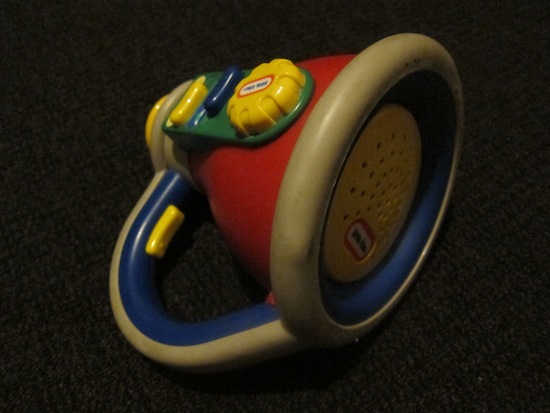
The megaphone, this goes with the Dictaphone a bit doesn’t it? I’ve seen you yelling into this at gigs whilst jumping up and down on the spot… isn’t that ruinous to your knees?
AdB: When I just joined The Ex and we released the ‘Maybe I Was The Pilot’ 7", a journalist described me as a “cartoon radical”. I take that as a compliment. This megaphone is just the right one for me. It has a volume knob and two switches; one is a pitch shift, so you can pitch your voice up or down or leave it normal. The other switch changes the sound; apart from using it as a megaphone it can also produce race car sounds, sirens and a laughing monkey sound. Exactly what I like. I like sirens and car horns and they have become part of my music. I also like children’s songs, they have had a big influence on my music too. So this megaphone is a favourite.
You seem to like distortion, things that are scratchy, dirty, analogue. Tho I wouldn’t say you had a lo-fi sound, your records are very clear and clean.
AdB: Thank you, I do try to create an open sound and to make the “audio space” large enough to fit all different instruments and melodies in, although my songs were more dense ten years ago then they are now. And yes, I don’t like smooth and loads of reverb. I like things direct and in the red, and although I learned to work with Pro Tools and computers and such through the years, I returned to Corno Zwetsloot’s analogue studio all the time because it is very clear what the tape and the desk and so are doing to sound. Every fader or knob you use is musical; it’s really an addictive universe to swim in.
9. Photo of the I Am Searching For An MP3! Floppy
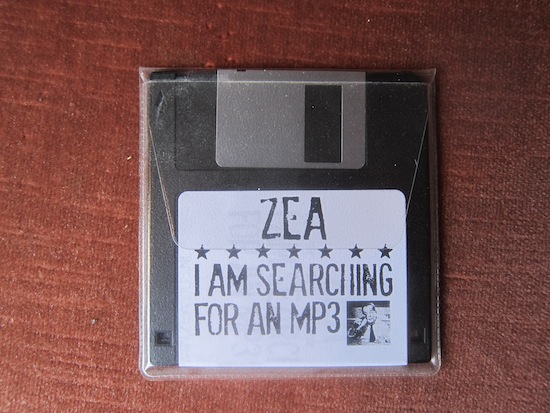
"I Am Searching for an MP3!" I haven’t got that though I have seen it on your "merch table" every now and then. Tell us about that.
AdB: Sometimes I whisper, mumble or say out loud what I am actually doing. Sometimes that sentence has a sort of melody, like the title of this song, and that gives me the start for a song. In 2005 I was searching for MP3s a lot, using Napster and Soulseek and surfing on band websites. We released this song on a floppy disk (1,5 minutes,128kbs;1.2 MB). We sold about twenty; floppy disks had already been overtaken by ZIP discs, USB sticks, CDRs and portable hard disks. But I have a few left for when the revival sets in. On the cover you see a small picture of Edison trying out his first audio recording. Recordings did not come from nowhere, the whole thing has been through a set of stages and the media is still changing all the time. Children who see a floppy disc these days think it’s a 3D print of the “save icon”. That is beautiful, a robot could, and never can, come with such a conclusion; but we need these historical mash-ups to get new ideas and be creative. The floppy disc isn’t floppy and it’s not a disc. As long as humanity continues thinking and acting along these lines of logic, we are not yet lost.
10. Today I Forgot To Complain LP
Now, I do have Today I Forgot to Complain, the record that is a classic Zea record; jumpy, funny, heartfelt, with a sideways way of looking at the world; and full of observations.
AdB: I picked this because it is a screen print of the image I made for the cover. I was asked to do an exhibition once with my drawings and was helped to make some screen prints from the artwork. I would have never thought this would happen while I’ve been making drawings for my songs, but it was great to do.
But why did you pick that particular LP and not, say your last LP, The Swimming City?
AdB: The album feels like my first full album although it was the second of course. Kowtow To An Idiot is like number 0; it was recorded and produced by Zlaya Hadzick. I learned a lot from him and from the whole process. He sold me his old Power Mac with a Pro-Tools soundcard built in. It only had eight tracks and you couldn’t add plug-ins, only render the effects on the sound files. And that is how I made Today I Forgot To Complain. I did everything myself, at home or in the storage room of my parents’ shop where I could make more noise. It was a very exciting and rich feeling to be able to control everything and to use all these digital features for making new sounds; cut and paste and mash-up, I loved it. And John Peel played it. The single ‘An Experience Of Trouble’ was in Peel’s Record Box, so I felt I was doing something right.
Jason Forrest remixed tracks from that didn’t he?
AdB: YEAAAAAH! Yes he did. He remixed ‘Kiss Kiss Revolution’ and it’s on the 12” called ‘One Bomb Fits All’ together with remixes by Melt Banana, Felix Kubin and 1-speed Bike. Jason is a good friend, he played on our label night a few times and we stayed at his house more than once on our USA tours. He used to do a show on the legendary WFMU radio station from Jersey City where we played some sessions too. Two days ago we played downstairs in the radio building with The Ex, really nice, everybody should check out WFMU.org.
And I should ask you about Transformed Dreams label, that seemed to be a very mysterious Amsterdam label. What happened to it?
AdB: It dissolved. Marcel Hermans started it in 1998 with the energy of ten horses. Together with him and Bas from the band Seedling, we did band nights in the red light district in Amsterdam. The collaboration started there. We eventually did 55 monthly label nights upstairs at The Paradiso. We worked our asses off, organising gigs and releasing records. We celebrated our successes with a label night in a packed Paradiso big room. The NME did a two page article about us, we went on tour in the UK, Persil and Seedling did Peel Sessions, and Zea did a One Music session with Huw Stephens. But it’s not easy to keep things running on full steam when some of the bands fall apart, and while these band members were still part of the whole thing. But we never gave up on our own ideas about music or on our take on the business side of it all. Ten years of “super power” is already a lot for a label that was much more than just a label; and unless a rich businessman comes to take over “the business” it comes to a sort of natural end, I guess. When Marcel started, underground off-kilter guitar bands were suffering in The Netherlands, everybody was saying that guitar music was dead and house, techno and Gabber were the future. Ten years later there were a dozen new independent labels and many new young and fresh bands around, and Transformed Dreams played a leading role in that process. Of course you should interview Marcel about the whole thing but that’s my two cents.
Zea host their 20.0 Festival on November 27 at OCCII in Amsterdam, Netherlands; for full details and tickets, head here

